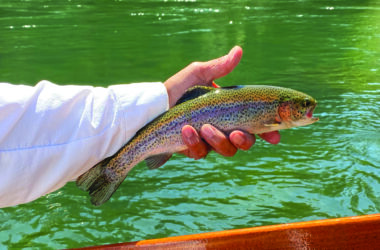 A trophy-size hatchery rainbow trout raised at Leaburg Hatchery, this one caught in the McKenzie River. Pink meat and suitable table fare, these fish range in size from one to over two pounds each. FRANK ARMENDARIZ/THE CHRONICLE
A trophy-size hatchery rainbow trout raised at Leaburg Hatchery, this one caught in the McKenzie River. Pink meat and suitable table fare, these fish range in size from one to over two pounds each. FRANK ARMENDARIZ/THE CHRONICLE
November used to be somewhat of a down month for local anglers. Fishing offshore falls to the hardest of sailors on seas where conditions can overtake the unprepared. Most high lakes and many streams saw the end of the general trout season on Oct. 31 – although there are exceptions; most notably, the McKenzie is open year-round.
The cold weather puts sunfish species such as bass into hibernation until next spring. It’s also the time between fall salmon fishing, which is wrapping up on most central coast rivers, and the beginning of winter steelhead season, which is still a few weeks away.
So last week, looking for ideas, I spoke with Jeff Ziller, the southern Willamette Valley managing fish biologist for the Oregon Department of Fish and Wildlife, and John Spangler, who fills the same role for the central Oregon coast district, which includes western Lane County. Spangler’s district has some of the best winter steelhead streams in the state, including Lake Creek and the Siuslaw, Alsea and Siletz rivers.
I’ll share my conversation with Spangler and information about the upcoming steelhead season in a future report, so stay tuned….
This week, at the top of this report, Ziller was happy to share that the Leaburg Hatchery is back online. The ODFW stocking trucks will be rolling, delivering abundant numbers of hatchery trout – and big trout at that! All are classified as ”trophy trout” and will be delivered to several urban water bodies in both Lane and Linn Counties next week and through the end of the year.
Actually, as the forward-thinking manager of our local fisheries, Ziller and the other folks at the Springfield office of the Oregon Department of Fish and Wildlife have endeavored for years to put more fish where more folks could catch them year-round. Hatchery trout were more often planted in the distant corners of our county, in rivers with little bank access, never in the winter, and were not always available to everyone. That changed a couple of decades ago and the approach has morphed into a year-round program to make angling available to more Oregonians.
Most immediately, starting the week of Nov. 11, Row River Nature Park will get 400 of these trophy fish, while 1,000 will go into Junction City Pond and 500 will be seeded along the length of the Alton Baker Canal. Locally, more trophy-sized hatchery fish will be planted again in the weeks of Nov. 25, Dec. 9, 16 and 23. The stockings into the three Lane County water bodies will continue, ramp up sharply in late March 2020 and include many more opportunities then.
Ziller also said that with Leaburg Hatchery coming back and with Desert Springs Trout Farm still contracted for a couple of more years, there will be a lot of trout available for south valley anglers for the next couple of seasons – about 277,000 pounds of trout, at three trout per pound, per year. Ziller plans to take advantage of the excess, with the lakes and ponds in the district being the largest beneficiaries.
The number of fish planted at Hills Creek, Fall Creek, Blue River and Dorena reservoirs and all other historically planted water bodies will get close to double the normal allocation. The Cape Cod stock trout raised at Leaburg will be the only hatchery trout planted in the McKenzie starting in April 2020.
Doing what they can to provide even more angling opportunities, Ziller also shared a plan to make hatchery spring chinook returning to the southern valley available to more anglers.
In light of the recently established bike and pedestrian paths that now run adjacent to the Middle Fork Willamette River, Ziller’s plan is to imprint about 500,000 hatchery salmon smolts to return as adults to the confluence of the Middle and Coast Fork Willamette, as he has done with steelhead, creating the increasingly popular ”town run.”
His belief is that spring salmon will hold at the confluence where bank anglers utilizing the path can more conveniently reach them, essentially creating a salmon fishery here in the middle of our increasingly urban environment.
Ziller did express his regrets that the 2019 season returns of spring chinook and particularly summer steelhead to the southern Willamette Valley was far from great. He explained that our migration conditions were great for the smolts and ocean conditions were also the best of the past decade, but the returns did not reflect those positives.
There was a bright spot that hopefully could represent the beginning of a trend. The numbers of ”wild” spring chinook returning to the upper Willamette basin was nearly double the previous years’ average. Recent counts found about 3,000 wild spawning spring chinook salmon in the upper McKenzie – a major Willamette tributary and home of the last viable population of wild chinook in the southern valley.
What’s important here is that because of legal rulings, hatchery chinook are released based on a ratio of the number of returning wild salmon.
The current average of about 1,500 to 2,000 allows 600,000 hatchery salmon to be released in the McKenzie River annually. More returning wild salmon could eventually allow for more hatchery salmon to be released. Let’s hope the trend continues.
Contact Frank via email at [email protected] or call 541-228-4084.








